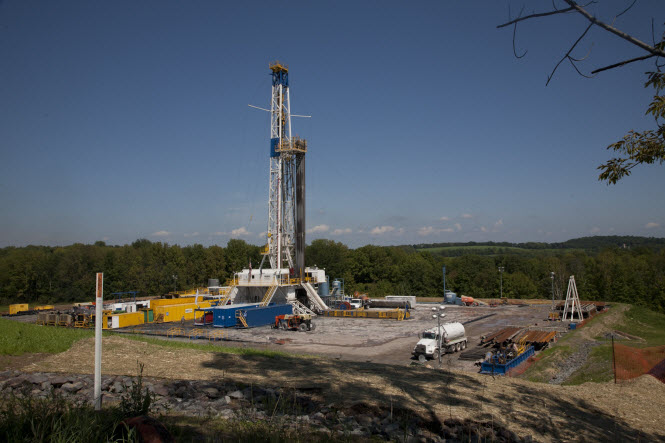 by Dan Aiello
by Dan Aiello
Reuters reports that the draft regulations announced by the Brown administration, set forth ostensibly to improve monitoring of the oil industry’s hydraulic fracturing, or “Fracking,” method of oil extraction from the state’s depeleted oil fields, are actually intended to increase the ability of the oil industry to use fracking in oil fields throughout California.
Fracking is controversial because of its environmental impact on the land and the state’s water and groundwater supplies, turning as much as 8 barrels of potable drinking water into a toxic soup known as “produced” water for every barrel of oil rendered. Fracking’s produced water has contaminated local groundwater supplies and rendered fertile agriculture acres into barren wasteland in counties like Kern, King, and elsewhere.
According to John Kemp, reporting for Reuters, California’s Democratic Governor Edmund G. “Jerry” Brown, Jr., made the December 18, 2012 announcement of new regulations for the largely unmonitored oil industry, intending to increase, not decrease, the number of fracking permits issued by the state.
California’s lack of enforcement over the state’s existing regulations was the issue of greatest concern to the state’s environmentalists, with California’s oil producers’ reputation for having a notorious disregard for existing water quality regulations – already on the books and well known in Sacramento.
Brown did not propose increased enforcement of the state’s Department of Gas and Geothermal Resources (DOGGR) or Department of Water Resources (DWR) regulations, only the additional fracking regulations that Kemp reports are intended as a gateway to expanding the extraction practice of hydraulic fracturing, or fracking – pumping water, steam and sand into the ground, to bubble to the surface heavy oil of a tar-like consistency.
According to Kemp, Brown’s published draft rules “could lead to widespread hydraulic fracturing for oil and gas.”
Kemp continued:
“Speaking to a conference last year, California Governor Jerry Brown, a Democrat, said he would look into issuing more permits for fracking if it could be done in a safe manner. “I’m an optimist,” that environmental concerns can be resolved, the governor said.
“California is the fourth-largest oil-producing state, and we want to continue that.”
Issuing draft regulation could be a first step toward a big expansion of the practice, reported Kemp.
Kemp cited the expansive Monterey Shale deposit as the most likely target for new fracking operations in California, a state that remains uncompensated for the extraction of its oil deposits, the only state or national government to lack such an extraction of severance tax in the world. The revenue from a ‘severance’ or extraction tax is used in all other states to pay for the monitoring of the oil industry, restoration of environments decimated by oil extraction, education and a host of other state needs. California’s past proposed legislation called for a severance tax that, at half the rates of Alaska, Texas and Louisiana, would have generated $1 billion dollars annually, but was defeated by pro-out-of-state oil industry legislators (97 percent Republican).
Our groundwater resources need to be protected from oil and gas development to prevent what happened to the farmer in this case from happening again,” said State Senator Lois Wolk (D-Davis), a stalwart defender of the Sacramento/San Juaquin Delta, California’s largest and most endangered estuary, from which the State Water Project aqueduct conveys the water Aera syphoned off and used to contaminate Kern groundwater.
“I am monitoring the development of state regulations governing hydraulic fracturing and am hopeful that, once adopted, these regulations would not only protect water quality from the impacts of fracking in the future, but let Californians know just how much water is being used for fracking purposes, given our limited supply,” State Senator Lois Wolk (D-Davis), told California Progress Report last week.
A cumulative 2.8 trillion gallons of water is said to have been used for fracking in California to date, water taken primarily from the endangered Sacramento/San Joaquin Delta estuary (now under threat of another peripheral canal proposal to drain 7 million acre feet of water that could wipe out several species of Northern California fish native to the largest estuary on the Pacific Coast), conveyed south via the state’s taxpayer -funded water conveyance system (aqueduct) and syphoned off for fracking by tax-exempt oil producers in Kern where it is processed into highly toxic waste – or “produced” water.
Wolk is a strong advocate for the adoption of a state policy of regional water sustainability and abandonment of the state’s politics and practices of resource exhaustion that have historically caused most of California’s water wars, where politically powerful “water-wanting” regions have cast sad nets over politically-weaker but water-rich regions – like the Delta, Owens Valley, Mono Lake and the Hetch Hetchy – instead of advocating regional sustainability statewide.
The regional water sustainability plan supported by Wolk is only possible if local groundwater supplies throughout the state remain potable. Fracking already has been proven to cause irreparable harm to California farmland.
The oil industry’s thirst for California’s other precious liquid is not widely known, outside the state’s environmental organizations and the oil industry itself. And oil producers’ thirst is growing as the depleted oil fields are exhausted. A decade ago, Kern County produced almost an equal amount of polluted wastewater as it did oil from fracking, approximately a 1/1 ratio.
By 2008, the barrels of oil were significantly reduced while the amount of water used to produce them had grown by 100 million barrels, annually, a 3+/1 ratio. And the amount of wastewater produced by Kern County annually continues to rise in the face of ever-decreasing oil production, with 2012 reporting a ratio of 8+ barrels of polluted water for every barrel of produced oil.